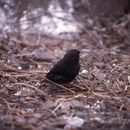Biology
provided by Arkive
Darwin's finches are distinguished by their highly specialised beaks, which enable each species to occupy a different ecological niche (6). The ground finches (Geospiza sp.) feed mainly on the ground and are generally granivorous, but also feed on arthropods and the fruit of Opuntia cacti (2) (6). In particular, small ground-finch populations in highland areas, such as on Santa Cruz, tend to spend considerably more time foraging in low vegetation (9). With its compact beak, this species is much more efficient at foraging for smaller food items than the other ground-finches, with the very small seeds of Sesuvium edmonstonei and Tiquilia fusca being typical components of its diet (7).
Darwin's finches generally breed opportunistically, with egg-laying being most profuse when rainfall is high and food abundant (2). Pairs are typically monogamous and maintain small territories within which they build a small dome-shaped nest in a bush or cactus. On average each clutch comprises three eggs that are incubated for around 12 days before hatching. The nestlings are mostly raised on insects and leave the nest after about two weeks (6).
During the breeding season, competition for resources between different species of finch can be extremely intense. In promoting ever increasing levels of specialisation, competition for resources has been the driving force behind the evolution of Darwin's finches. This is exemplified by the widely divergent beak sizes of different finch species co-inhabiting one island, compared with much more convergent beak sizes when the same species are isolated from each other on separate islands (6).
Conservation
provided by Arkive
For their unique biological diversity and significance, the Galapagos Islands are designated both a National Park and a World Heritage Site. As a consequence, conservation of the islands' native fauna and flora is a high priority (12). Furthermore,scientists from the Charles Darwin Foundation continue to conduct further research on Darwin's finches in order to ensure their long-term conservation (10).
Description
provided by Arkive
Motivated by the breadth of morphological variation he witnessed in the Galapagos' thirteen finch species, Darwin mused that “seeing this gradation and diversity in one small, intimately related group of birds, one might really fancy that from an original paucity of birds in this archipelago, one species had been taken and modified for different ends.” (3) (4). In accordance with their apparent influence on his theory of natural selection, this group of closely related passerines has come to be known as Darwin's finches. One of the commonest species of Darwin's finches is the small ground-finch (3). Like the other ground finches, the adult male plumage of the small ground-finch is completely black while the female is brown and streaked (2) (5). Compared to the other ground finches, the small ground-finch has a reduced beak size, making it adept at foraging for small seeds (6) (7).
Habitat
provided by Arkive
Occurs mainly in the arid lowland zones, dominated by cacti, deciduous shrubs and dwarf trees, but on the elevated islands it is also found in the moist highland forest where Scalesia dominates (5) (8) (9).
Range
provided by Arkive
The small ground-finch is endemic to the Galápagos, where it occurs on the islands of Pinta, Marchena, Floreana, San Cristóbal, Santa Fe, Daphne Major, Santa Cruz, Pinzón, Rábida, Santiago, Fernandina, Española, Isabela, Baltra and Seymour (2).
Status
provided by Arkive
Classified as Least Concern (LC) on the IUCN Red List (1).
Threats
provided by Arkive
In common with much of the Galapagos' endemic fauna and flora, Darwin's finches are under threat from habitat destruction, introduced diseases, and invasive predatory species such as rats and cats (10). However, the small ground-finch is still relatively abundant and is not thought to be undergoing a significant decline (11).

